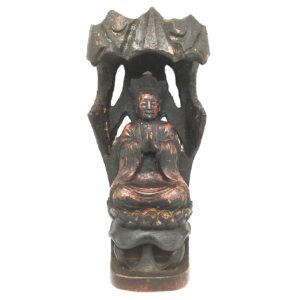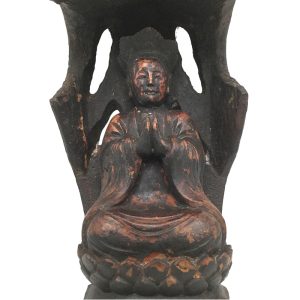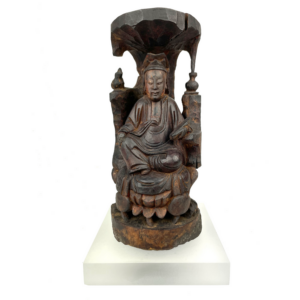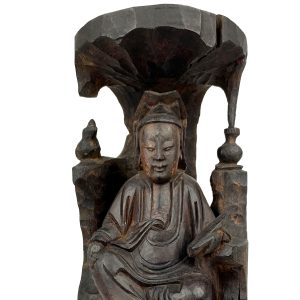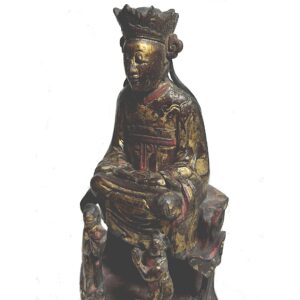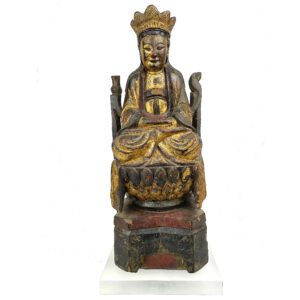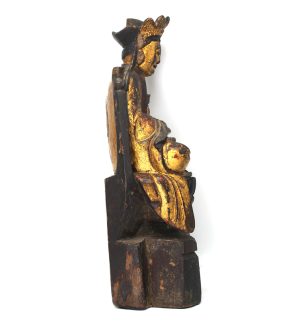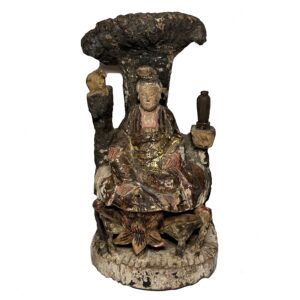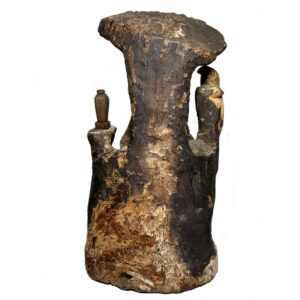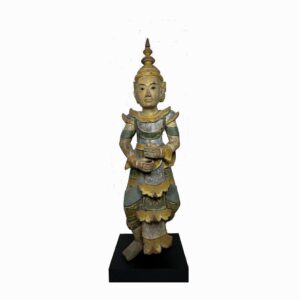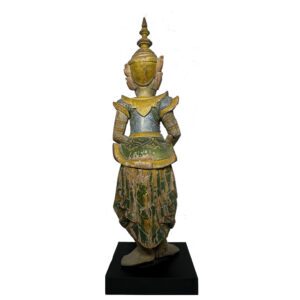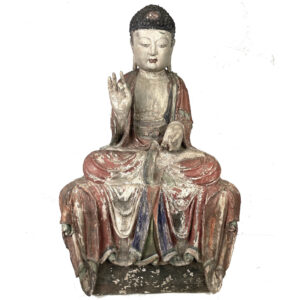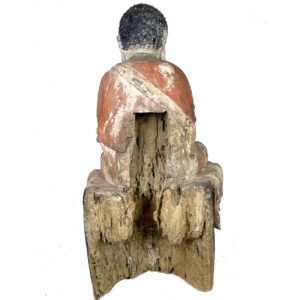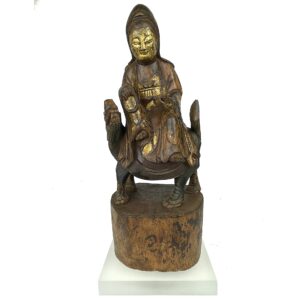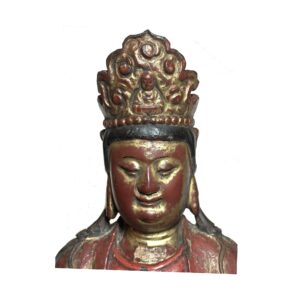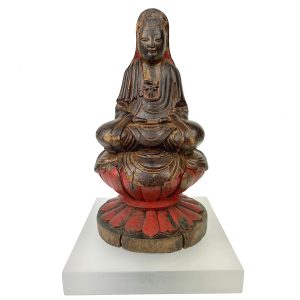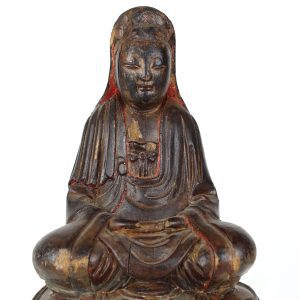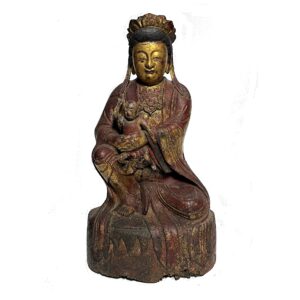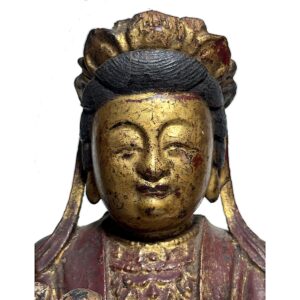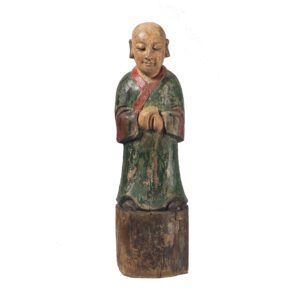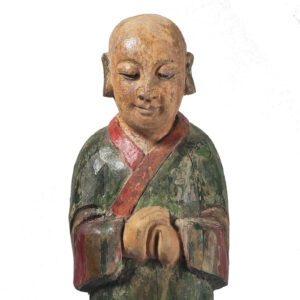Showing 13–24 of 47 results
-
Sale!


$450.00 Original price was: $450.00.$325.00Current price is: $325.00.
H: 11.75″ W: 5.25″ D: 4.75 ” | Free shipping within continental us
Provincial Nanhai Guanyin palms at heart in anjali mudra, a mudra of offering rarely used for Nanhai Guanyin. On lotus throne at Tidal Cave on Putuo under a craggy rock outcrop with pierced openwork.
-
Sale!


$750.00 Original price was: $750.00.$500.00Current price is: $500.00.
H: 9.5 ” D: 4.5″ | FREE SHIPPING WITHIN CONTINENTAL U.S.
Rare provincial white hooded Nanhai Guanyin in Cave below openwork draped moss and barbed rocks holding precious scrolls, with vial and parrot. Open lotuses symbolize her purity and enlightenment, closed lotuses potential for enlightenment of others.
-
Sale!


$1,350.00 Original price was: $1,350.00.$1,200.00Current price is: $1,200.00.
H: 11.5″ W: 6″ D: 4.5″ | FREE SHIPPING IN CONTINENTAL U.S.
Nanhai Guanyin on Mount Putuo sits as a triad with acolytes Shan Tsai hands in prayer and the Dragon Princess offering the “illuminating pearl.” Very rare Ming sculpture on an Acrylic base is one of our favorites VA collection carvings.
-
Sale!


$1,450.00 Original price was: $1,450.00.$1,150.00Current price is: $1,150.00.
H: 15.5″ W: 6″ D: 5.25″ | CALL 213-568-3030 OR EMAIL VANISHINGARTS213@GMAIL/COM for shipping information
Elegant Guanyin in meditation, gilt covered with five-lobed crown. Sacred vial on her right and parrot on left. Guanyins statues with symbols in this condition are rare and impart a feeling of serenity to the environment around them.
-
Sale!


$595.00 Original price was: $595.00.$525.00Current price is: $525.00.
H: 9.75″ W: 5″ D: 4.5″ | FREE SHIPPING within continental u.s.
Nanhai Guanyin in her Cave in lalitsana, below draped moss arch holding a scrolls, next to vial of humanity’s tears and parrot, her constant companion. Small Nanhai images with these symbols are very rare.
-
Sale!


$1,200.00 Original price was: $1,200.00.$950.00Current price is: $950.00.
H: 25″ W: 8″ D: 6″ | CALL 213-568-3030 OR EMAIL [email protected] FOR SHIPPING.
Regional Rattanakosin carving of a Thai celestial guardian or attendant originally placed on a home or small temple for protection and devotion. Stylized layered garment, intricate detailing and headdress signify his celestial and royal status.
-
Sale!


$4,500.00 Original price was: $4,500.00.$3,300.00Current price is: $3,300.00.
H: 30″ W: 18″ D: 10″ | | CALL 213-568-3030 OR EMAIL [email protected] FOR SHIPPING.
Superb, colorful and rare Buddha in teaching (vitarka) mudra appears to float above swirling cloud. Fine features, graceful body and exquisitely rendered drapery make this a truly striking statue. Given its size and masterful carving, it should be revered commensurate with its spirituality and artistry.
-
Sale!


$725.00 Original price was: $725.00.$585.00Current price is: $585.00.
H: 15.125” W: 6” D: 5” | FREE SHIPPING within Continental U.S.
Rare provincial carving of Guanyin in lalitsana clasping a rosary on a mythical Hǒu that symbolizes righteousness, morality and ushers in peace and prosperity. Small yet powerful, consecrated and mounted on Acrylic base.
-
Sale!


$3,750.00 Original price was: $3,750.00.$2,900.00Current price is: $2,900.00.
H: 19″ W: 10″ D: 8″ | CALL 213-568-3030 OR EMAIL [email protected] for shipping INFORMATION.
Wonderfully carved Nanhai Guanyin with ornate and beautiful diadem centered by elaborately framed Buddha Amitabha in meditation. Vibrant aura radiates spirituality, opulence, serenity and strength, as well as compassion and grace, making this a truly masterful piece of art.
-
Sale!


$495.00 Original price was: $495.00.$395.00Current price is: $395.00.
H: 8.675″ Dia: 4.5″ | Free SHIPPING WITHIN CONTINENTAL U.S.
Delicate white robed Guanyin in meditation on radiating lotus throne. Provincial humble, modest, relatable, yet beautiful matronly figure.
-
Sale!


$2,650.00 Original price was: $2,650.00.$1,975.00Current price is: $1,975.00.
H: 14.5” W: 8.25” D: 5” | CALL 213-568-3030 OR EMAIL [email protected] FOR SHIPPING.
Rare and beautiful provincial Songzi Guanyin is modest, compassionate and humble with lotus leaf crown, unadorned robe and pedestal with simple leaves. Her baby resembles the infant Buddha. Was probably on a home altar of wealthy couple desiring a (male) baby.
-
Sale!


$1,850.00 Original price was: $1,850.00.$1,450.00Current price is: $1,450.00.
H: 27.5” W: 8.5” D: 6.5” | CALL 213-568-3030 OR EMAIL [email protected] FOR SHIPPING.
inspirational, serene monk with realistic youthful smiling face on tall pedestal symbolizing his spiritual significance. Size, pose and consecration suggest was in spiritual space in a home or community shrine. His serenity and grace transforms environment around him.
End of content
End of content

